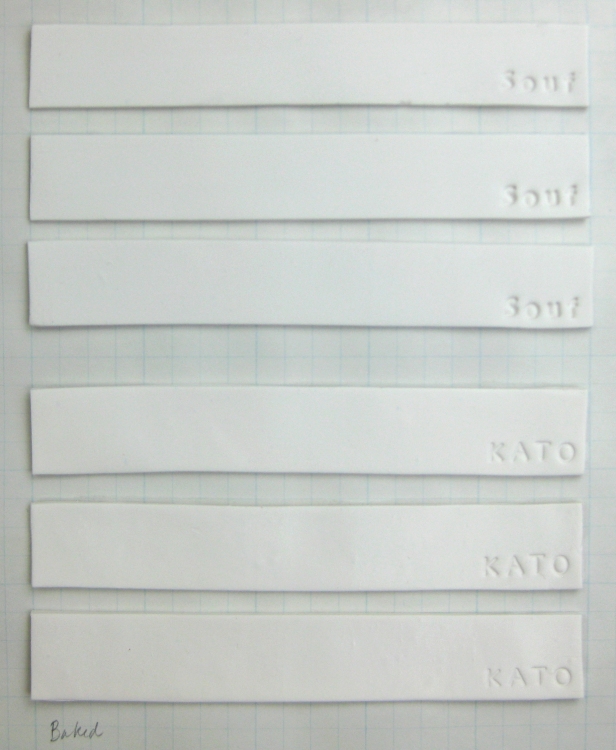
I was recently reading The Polymer Arts magazine, which I really enjoy. One article said polymer clay doesn’t shrink. Another article in the same issue said it does. I’m sure those are true experiences for each author, but it’s confusing for novices like me.
A few months ago, I made two tissue blade cases using Kato polymer clay. I cut the clay to perfectly fit around the magnetic sheets I’d cut. I was surprised that after baking the cases, the magnetic sheets no longer fit. I had to trim over 1/16″ off the length and a tiny bit off the width to get them to fit again.
Why had I read so often that polymer clay doesn’t shrink when clearly it does? The answer is simple. Some brands shrink, some don’t.
The photo above shows unbaked strips of Fimo and Cernit. The photo below shows the same strips after baking. There’s a tiny bit of shrinkage in the length of Fimo. You really have to look for it. I can’t see any shrinkage with Cernit.

Below is Premo before and after baking. (I love before and after photos.) There’s been about 1/16″ shrinkage in the length.


I also tested Kato and Soufflé. Kato shrunk about 1/16″ in length. It’s difficult to see any shrinkage in Soufflé.


So, now I know. Premo and Kato shrink a little. Fimo shrinks a tiny bit. Soufflé and Cernit don’t seem to shrink at all.
Most polymer clay projects are small, so it may not matter if a 5″ piece of clay shrinks 1/16″. It depends upon what you’re making. I’ve had seams come partially open because of shrinkage.
I’ll keep shrinkage in mind if I’m making a large piece where precision is important, or if pieces baked separately need to fit well together. It’s good to know that depending upon the brand, polymer clay does shrink.



This is the post that led me to your blog. And I have a question…
I normally deal in 1/48 scale plastic models, and I want to create a diorama. In the modelling community they tend to use Milliput, which is a two-part sculpting epoxy.
I was thinking of FIMO, but I didn’t know there were other brands.
Basically, I need to make a 1cm tall rabbit, that I will have to paint with acrylics.
Shrinkage isn’t a problem since wildlife can be any size. I was wondering what your thoughts or recommendations are for making such a tiny sculpture.
How easy are they to sculpt with tools, etc.
And especially are there going to be air bubbles?
I only clinged onto FIMO because I used it in grade school haha.
LikeLike
Fimo and Cernit make clays specifically for sculpting dolls, though any of the brands of polymer clays can easily be molded by hand or sculpted with tools. Air bubbles (or what we call plaquing) are more of an inherent problem with Fimo and Kato, but you can get them in any clay if you trap air in the clay when you condition it. (You have to condition it before use by kneading it thoroughly or folding it and running it through a pasta machine about 15 times. Not a pasta machine you’ll ever use for making pasta again.) Premo is a softer clay that many people like and you should be able to find it at your local craft store. After you paint it, I’d suggest putting it back in the oven for 10-15 minutes to help the paint adhere better to the clay, because certain brands will scratch off. I have another blog post on painting baked polymer you might want to look at.
LikeLike
Good to know about the shrinkage. I’m about to build a docking station for a phone and shrinkage matters alot in precision fitting.
LikeLike
Yes, I found out the hard way.
LikeLike
I’ve just tried this with a 10cm (~4 inch) strip of Super Sculpey Original, rolled through my Makin’s machine on setting 1 (about 2mm). I ticked off the 1cm, 5cm, and 9cm marks before baking. I let it cool in place on a glazed tile, then measured it again.
Overall the strip seems to have shrunk approximately 1mm in length, in other words it shrank by 1%.
LikeLike
Thanks for sharing your results!
LikeLike
I’ve just tried this with some Super Sculpey Original.
I rolled a sheet through setting 1 on my Makin’s clay machine, about 2mm or close to 1/6th of an inch thick. I cut the length to 10cm, or just about 4 inches. I ticked off marks at 1cm, 5cm, and 9cm. The strip was baked on a tile and then allowed to cool in place before being removed to measure again.
Overall, the 10cm strip of unbaked clay shrank by 1mm after cooling, or about 1%. That’s less than 1/16th over the 4 inch length of clay. If someone else tries and gets different results, I’d like to know!
LikeLike
Thank you, that was very useful
LikeLike
Thanks Tanja!
LikeLike